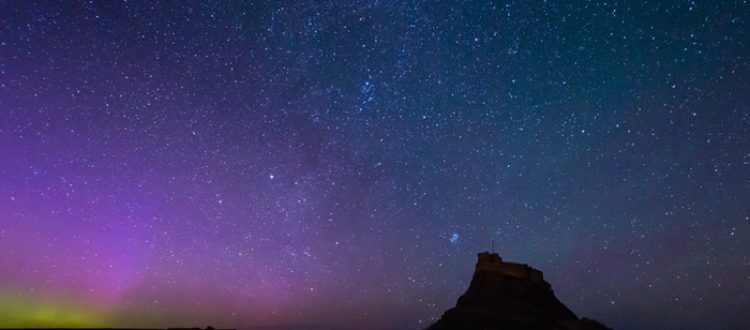One of the best places in England to view the Northern Lights
The appearance of the Northern Lights (Aurora Borealis) on the Holy Island of Lindisfarne doesn’t happen every year, but when it has a chance of making an appearance, there is usually some warning a few days ahead. If you live in Southern England, you could always check the likelihood on the day, and hop on a train (3h30m to Berwick) to get here. Worse case, if the Aurora doesn’t appear, you’ll still have an opportunity to spend a day on the beautiful Holy Island and see the Castle and Priory.
Bearing in mind that Holy Island is close to the northernmost town in England (Berwick-upon-Tweed), and has virtually no light pollution, it’s one of the best places in England to see the Aurora, especially as it appears over Lindisfarne Castle or reflects in the waters of the causeway. There are some absolutely astounding pictures of it from previous displays.
After we moved to the Island, I was excited about living in a place where the Northern lights are sometimes visible, and researched how I could have early warning, and what would affect the chances on the day. Here I’ll share with you what I learned.
The very short science bit: If you’re reading this, you’ll probably already know that the aurora is caused by charged particles from the sun that enter Earth’s atmosphere and collide with gas particles. Or you might just be interested in the sparkling lights in the sky, which is absolutely fine…
What you’ll actually see
I don’t want to oversell the aurora and create expectations of the wild green waves you see in pictures of the island/causeway. In reality, if there’s a display, you’ll see some green in the sky (maybe a bit more if there’s a high-level solar storm). The magic happens when you are able to capture it on a camera (or phone) with the right settings. Because camera lenses are more sensitive and are able to capture images with longer exposures, what seems to the naked eye like a bit of green, shows up in pictures as proper and sometimes spectacular aurora displays.
Taking those lovely pictures
First and foremost move away from any light sources that might interfere with your picture, but do be careful as you walk around the island in the dark and take a torch with you to see where you’re going.
If you are using a modern mobile phone, use ‘night mode’ and place the phone on a solid surface such as a rock or wall (or on a tripod, if you have one) so it doesn’t move for the duration of the picture’s exposure. Latest phone models do this better.
If you have a more fancy camera, such as a DSLR, there are plenty of online guides that include the optimal settings, such as this one.
When is the best time to view the aurora in the UK?
Between September and April, after dark.
How to find out if an aurora might be seen in Holy Island and Northumberland
Your first point of call should be the BGS Global Geomagnetic Activity Forecast. The three-day forecast will rank from quiet to severe magnetic storm (G1-G8). Although a Storm G1 indicator means a good chance for Northern Scotland Storm G2 means a higher likelihood for us here, anything above G2 is rare, but you never know. Predictions for solar storms are not an exact science, so as soon as G1 is reached, there’s always a chance it will spike up and we’ll get a Northern Lights display in Northumberland.
The next thing you’ll want to check is the weather forecast. There are two more conditions that need to be met: 1) the sky should be clear of clouds, and 2) the moon should not be too full, or its light might be too bright for an aurora.
If the numbers are high and the sky is clear of clouds and moon, is an aurora guaranteed?
In a word: no. Aurora forecasting is improving, but is not perfect, and it takes a good confluence of events for it to be visible here. There is also no good way of knowing exactly when the aurora will show itself. Keep a watchful eye on the alert services below.
Can I get alerts of potential Northern Lights displays?
Yes. The Space and Planetary Physics group at Lancaster University’s Department of Physics offers a free alert service for when the Northern Lights might be visible from the UK. Note that their alerts are usually at the time of increased solar activity (i.e. when, or just before an aurora is expected), so if you are planning this from a distance and you are not onsite, then you might want to check the Aurora Service three-day forecast I noted above.
For alerts on your phone, the most popular app is the Glendale App.
I also post early alerts from the British Geological Survey on our Holy Island Facebook Group when they forecast an increase in solar activity, which may result in an aurora display.
Current aurora status in the UK
And here is a Youtube video (credit: Mark Dobson), of the Aurora seen on Holy Island in 2014:

